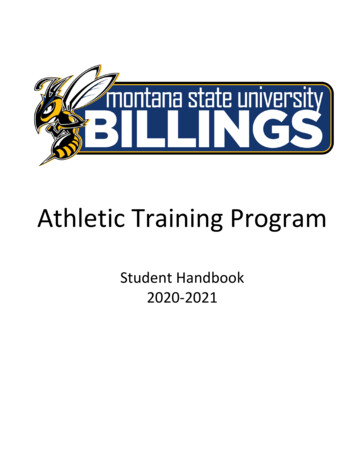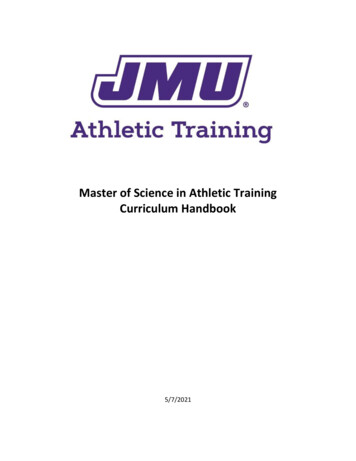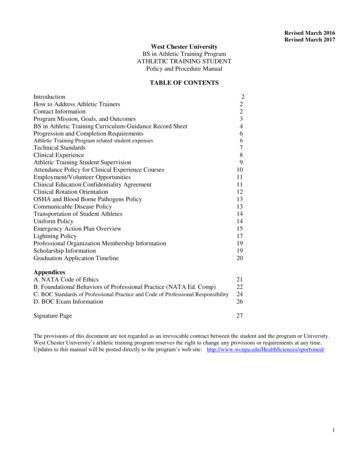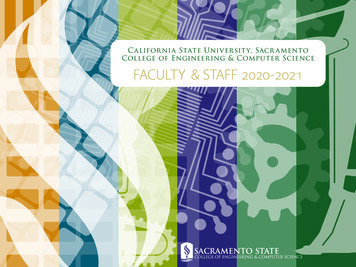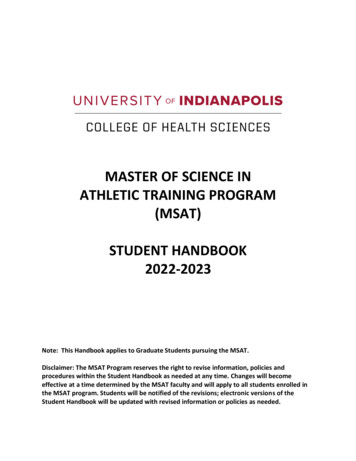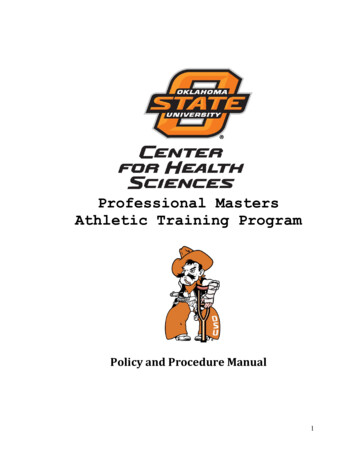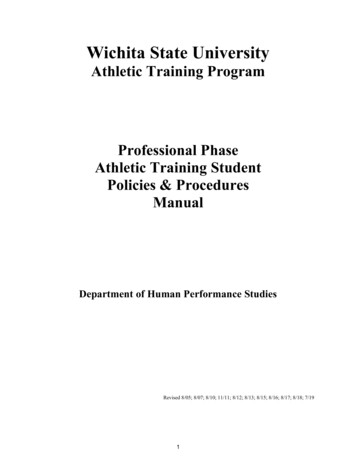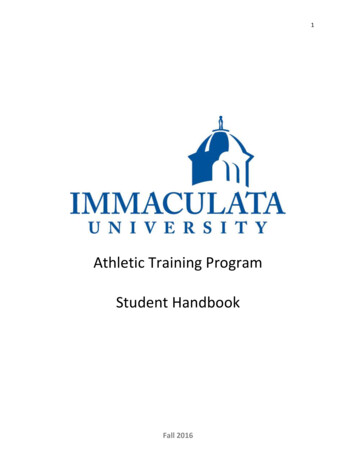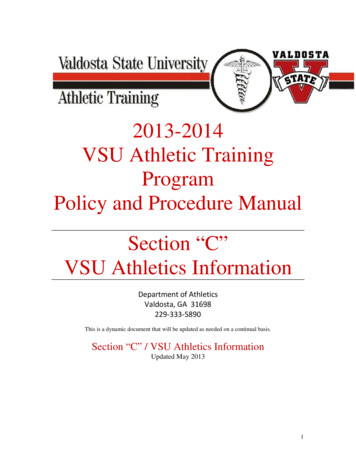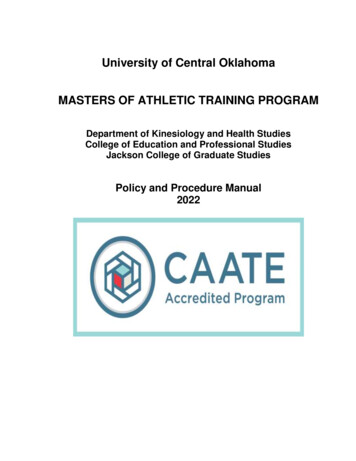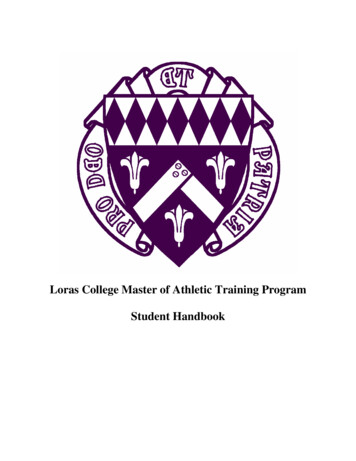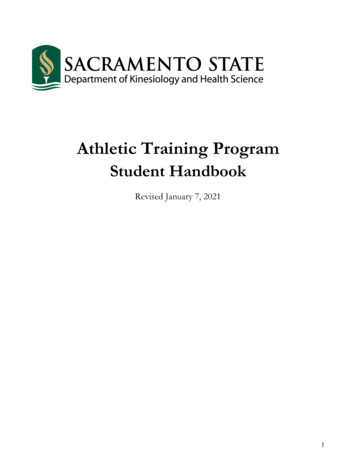
Transcription
Athletic Training ProgramStudent HandbookRevised January 7, 20211
Table of ContentsTable of Contents . 2Definition of Athletic Training . 3The Certified Athletic Trainer . 3Introduction to the Mission Statement. 3Mission Statement of ATP . 4Specific Goals for the Athletic Training Student (ATS) . 4Academic Program . 5Admission to the ATP . 5Application & admission Requirements—Clinical Program . 5Athletic Training Program Clinical Program . 6KINS 195D, Practicum in Athletic Training (Phases II, III, IV, V) . 7CAATE Accredited ATP Curriculum (Fall 2017-Present)*‡ . 8Sequence of Coursework . 9Documentation of Clinical Hours . 9Advising . 10Evaluation in the Program . 10Athletic Training Students - Expectations and Responsibilities . 10Clinical Hours: Schedules and Hours . 10Selection of Clinical Athletic Training Students . 10Rotation for Athletic Training Student Placement . 11Dress and Appearance . 11Student Code of Conduct and Professionalism . 11Athletic Training Student Club . 12Athletic Training Education Program . 12Faculty and Staff . 12Facilities . 12Cost of the Program . 13Probation/Interruption in Enrollment in KINS 195D . 13Dismissal from the Program . 14Appeal Policy . 14Confidentiality. 14Request to Start Fieldwork Late . 14Nondiscrimination Policy . 15Liability Insurance and Background Checks . 15Alcohol and Other Drug Policy . 15Student Grievance Procedures . 15Policy against Harassment and Retaliation . 15Blood Borne Pathogen Policy . 15ATP Communicable Disease Policy . 152
IntroductionThe California State University, Sacramento, (CSUS) Athletic Training Program (ATP) was first approvedby the National Athletic Trainers Association (NATA) in 1976. The Commission on the Accreditation ofAllied Health Education Programs (CAAHEP) accredited the program in October 18, 1996. The programearned initial accreditation from the Commission on the Accreditation of Athletic Training Education(CAATE) on July 15, 2006. The program is very strong academically as demonstrated by the core of sciencecourses in the Athletic Training major. The specific athletic training classes have a very extensive hands-onexperience for the students. For the clinical portion of the program, students rotate into clinical athletictraining sites under the direct supervision of Board of Certification (BOC) certified athletic trainers. Uponcompletion of this ATP, the student will graduate with a Bachelor of Science degree in Athletic Training andwill be eligible to sit for the BOC national certification exam to become a certified athletic trainer (ATC).California State University, Sacramento was founded in 1947 as Sacramento State College. It is one of 23campuses of The California State University system. The ATP is located in the Department of Kinesiology(KINS) within the College of Health & Human Services (CHHS).NOTE: Spring 2021 is the last semester CSUS will be offering coursework for the BSAT degree.Any student wishing to graduate with a degree in Athletic Training must successfully complete allcoursework and requirements during the Spring 2021 semester. There will be NO exceptions.Students not able to successfully complete coursework and requirements will be advised into a newmajor to meet graduation requirements. Students who do not successfully complete courseworkand requirements for the BSAT degree will NOT be able to sit for the BOC exam.Definition of Athletic TrainingAthletic Training encompasses the prevention, examination, diagnosis, treatment and rehabilitation ofemergent, acute or chronic injuries and medical conditions. Athletic training is recognized by the AmericanMedical Association, Health Resources Services Administration and the Department of Health and HumanServices as an allied health care profession (https://www.nata.org/about/athletic-training).The Certified Athletic TrainerCertified athletic trainers have fulfilled the requirements for certification established by the Board ofCertification (BOC) (www.bocatc.org). Athletic trainers are healthcare professionals who render service ortreatment, under the direction of or in collaboration with a physician, in with their education and trainingand the states’ statutes, rules and regulations. As part of the health care team, services provided by ATsinclude injury and illness prevention, wellness promotion and education, emergent care, examination andclinical diagnosis, therapeutic intervention, and rehabilitation of injuries and medical ining/athletic-training-glossary).Athletic Training Student (ATS)A student currently enrolled in courses while matriculating through a CAATE accredited professionaleducation program etic-training-glossary).Introduction to the Mission StatementThe Department of Kinesiology mission statement has multiple goals that relate to the broader educationalmission of the university. These goals are consistent with other programs at Sacramento State and withother Kinesiology programs throughout The California State University system. Athletic Training studentsare expected to adhere to the knowledge, skills, and attitudes expected of other Sacramento State studentsand other Kinesiology students throughout the CSU system. Additionally, athletic training students areexpected to meet the standards and expectations of the goals related to the mission of the Sacramento StateATP.3
Mission Statement of ATPIt is the primary mission of the undergraduate Athletic Training Program (ATP) to prepare the student witha quality education through knowledge, skills and attitudes to become a competent entry level BOC athletictrainer (AT).Specific Goals for the Athletic Training Student (ATS)Goal 1Students will extend the broad-based knowledge learned in their core Kinesiology classes to analyze,critically think, and solve problems as they relate to the areas of injury and illness prevention, wellnesspromotion and education, emergent care, examination and clinical diagnosis, therapeutic intervention andrehabilitation of injuries and medical conditions.Measurable OutcomesThe knowledge and skills specific for individuals to become a competent entry level BOC athletic trainer arelearned and evaluated in the following class and experiences:1.Care of Athletic Injuries (KINS 156) – The student participates in labs on the principles of athletictraining including upper and lower extremity recognition of injury, rehabilitation, initial assessment,taping and wrapping.2.Principles and Techniques in a Clinical Setting (KINS 154A) – The student demonstrates skill inrecord keeping, patient transfers and ambulatory techniques, literature searches and administrationof therapeutic modalities. The student will also gain knowledge on professional ethics, evidencebased practice, medical terminology, understanding the roles and responsibilities of health careprofessionals and the principles of pain and healing.3.Clinical Evaluation of the Upper Extremity (KINS 155A) and Clinical Evaluation of the LowerExtremity (KINS 155B) – The student demonstrates skill and knowledge in the taking of aneffective medical history, inspections, functional and special tests and palpation of identified parts ofthe body.4.Therapeutic Exercise (KINS 157) – The student demonstrates knowledge and the principles andprescription of therapeutic exercise including stretching, strengthening exercises, ProprioceptiveNeuromuscular Facilitation, flexibility, conditioning, stability, balance, relaxation and workhardening programs. A portfolio of a rehabilitation program for a patient or athlete is required.Goal 2Athletic training students will engage in problem-solving clinical experiences that will help prepare them forthe BOC national certification exam.Measurable OutcomesStudents will successfully complete a series of intervention techniques under the direct supervision of aPreceptor. Through fieldwork (Practicum in Athletic Training, KINS 195D) in the athletic training facilities,scheduled time with a Preceptor and the Monday night seminars, the athletic training student will respond tochallenges set by the preceptor in the form of mock exams, role playing, scenarios and demonstration ofskills.Goal 3The student will be given opportunities to develop confidence, self-worth, socialization skills that enablethem to reach out to diverse populations of students with an appreciation, compassion and empathy for4
their uniqueness. They are able to serve as positive role models and impart values that are consistent with ademocratic society.Measurable OutcomesThrough varied field placements in diverse settings, students are able to experience and foster the humandimension of learning and cultivate an appreciation for diversity and value of humankind. Evaluationinstruments (such as competency evaluations, mock exams, and scenarios) for field experiences addressknowledge as well as attitudes. These evaluation instruments are used by the preceptor each semester toevaluate the student on athletic training knowledge, skill and values.Goal 4All athletic training students are expected to commit to the professional development and responsibilitynecessary to be an effective BOC athletic trainer.Measurable OutcomesThe commitment is measured through their continual evaluations (mid-semester and end of semesterevaluation) in fieldwork (KINS 195D) experiences. Evaluation instruments used by the preceptor for fieldexperiences address professionalism and responsibility. Through the daily interactions in the athletictraining facility with the student-athletes, coaches and staff, the student is observed on his/her ability tohandle the situations that arise.Academic ProgramAdmission to the ATPStudents applying for admission into the Sacramento State ATP would require admission into SacramentoState and select Athletic Training as their major. Fall 2018 is the last time students will be admitted to theuniversity as declared AT majors. No changes into AT major are processed by the university after Fall 2017.Admission to the clinical portion of the program is competitive and requires a formal application andinterview. The admissions packet with the necessary forms can be found on the Sacramento State ATP website at: mlApplication & admission Requirements—Clinical Program§ Student Information Sheet§ Minimum B grade in BIO 25 & 26 (or equivalent), KINS 154A, KINS 156 (may be concurrentlyenrolled in BIO 26, KINS 154A and/or KINS 156 the semester applying for clinical admission).§ Proof of 2.80 GPA (copy of current grades) (Minimum GPA of 2.80 in each semester and overall GPAin ten graded units toward the degree; activity courses do not count as graded units)§ Minimum 150 hours of supervised and documented clinical experience by a BOC certified athletictrainer for clinical proficiency verification (see web page for ram.html)§ May be in progress of obtaining hours and completing skills the semester you apply§ One page typed statement of athletic training goals and reasons for wanting to be a part of theSacramento State ATP§ Proof of current First Aid, AED and CPR certification (copy of cards); any national certifying agencywill meet this requirement§ Two letter of recommendation forms from a teacher, athletic trainer or supervisor; see ATP webpagefor form5
§§§§§§§Physical exam form (proof of current physical exam stating that the student is able to perform the dutiesof an athletic training student) signed by a MD/DO/NP/PAProof of Hepatitis B immunization, or signed waiverAnnual TB test and resultsProof of medical history as part of the physical examSigned Technical Standards form /kinesiology/ internal/documents/tech-standards-update.pdf)Proof of professional liability insurance (see Program Director for details)If determined qualified by application packet, applicant must also pass a written exam (based on KINS156, KINS 154A, BIO 25 & 26) with minimum 80% score AND physical skills demonstration withminimum 80% scoreAfter a review of the application and interview/evaluation of the athletic training student, the preceptorswill recommend one of the following: Assignment as an athletic training student in the Phase II pool for possible placementRecommend the student see the Program Director for advisingClinical Program Application Due Dates: March 15 for fall admissionOctober 15 for spring admissionNOTE: Last application for clinical admittance is March 15, 2020, for consideration of Fall 2020clinical placement. Students entering clinical program Fall 2020 must complete 4 consecutivesemesters of KINS 195D (clinical placement). Students admitted enrolled in KINS 195D beginningFall 2020 who cannot successfully complete 4 consecutive semesters of KINS 195D will need tochange major in order to earn a degree from the university.NOTE: Spring 2021 is the last semester CSUS will be offering coursework for the BSAT degree.Any student wishing to graduate with a degree in Athletic Training must successfully complete allcoursework and requirements during the Spring 2021 semester. There will be NO exceptions.Students not able to successfully complete coursework and requirements will be advised into a newmajor to meet graduation requirements. Students who do not successfully complete courseworkand requirements for the BSAT degree will NOT be able to sit for the BOC exam.Athletic Training Program Clinical ProgramThe clinical portion of the ATP consists of four semesters of experience in the athletic training facilities.These semesters are divided into four phases of fieldwork. Phases II through V (KINS 195D) are four fullsemesters of fieldwork in various athletic training facilities. Students must formally apply to this part of theprogram each semester. An interview (with the Interview Committee) and a submitted application arenecessary for initial admission into KINS 195D, Practicum in Athletic Training. An application andinterview are also necessary if a student sits out for a semester and then wants to re-enter. The top studentswho qualify, are selected and placed with a preceptor for their clinical experience.6
KINS 195D, Practicum in Athletic Training (Phases II, III, IV, V)Criteria for enrollment in KINS 195D, Practicum in Athletic Training1.Declared Athletic Training major2.Minimum GPA of 2.80 GPA in overall and each semester in a minimum of ten* graded units,approved by the Program Director, toward the degree.3.Minimum B grade in prerequisites BIO 25 & 26, KINS 154A, KINS 1564.Completed application for KINS 195D, Practicum in Athletic Training5.Interview with Interview Committee. Interview is for initial appointment and if there is a break inenrollment6.Current certification in First Aid, AED and CPR7.Proof of current physical exam stating that the student is able to perform the duties of an ATS8.Proof of Hepatitis B immunization and TB testing and results9.Proof of medical history as part of the physical exam10.Signed Sacramento State ATP Technical Standards Form (form on website)11.Signed ATS Volunteer contract12.Appropriate availability for earning hours/experience during clinical placement (see ProgramDirector for advising of academic schedule)13.Proof of professional liability insurance (see Program Director for details)Clinical Education PolicyThe Sacramento State Athletic Training Program (ATP) will abide by the requirements set by CAATE forthe structure and execution of the clinical education experience. Each athletic training student (ATS) in the major will successfully complete four semesters (twoyears) of clinical experience by completing Phases II through V (KINS 195D Practicum) andearning a credit grade to advance to the next phase. Each ATS will earn experience with the athletic teams in either the Broad Fieldhouse AthleticTraining Facility (ATF), Yosemite ATF, American River College, Sierra College, Folsom LakeCollege, or Sacramento City College. This includes the following sports: (W) volleyball, (W)gymnastics, (MW) basketball, (MW) golf, (MW) tennis, (W) softball, (W) rowing, (W) sandvolleyball, (M) football, (M) baseball, (MW) track and field, (MW) cross country, (MW) soccer,(MW) water polo, (MW) swimming, (MW) tennis, (W) softball, wrestling, and (MW) diving Each ATS in Phase V, will observe in the Student Health and Counseling Services for the purposeof exposure to learning about general medical conditions Each ATS in Phase III will observe at Results Physical Therapy and Training Center for a one totwo- week period to be exposed to different populations Each student is responsible for being evaluated (minimally) by the preceptor at mid-semester and atthe end of the semester Each student cannot perform skills on any patient/athlete until he/she has completed formalcoursework and been evaluated on the skills by an preceptor Each student in KINS 195D is responsible for earning a minimum of 15 to a maximum of 20 hoursper week under the direct supervision of the preceptor (see CSUS Student Employment Policies andProcedures) during the academic semester The ATS must document his/her clinical hours on the designated form and turn the hours into theClinical Educator Coordinator (CEC) by the deadlines established The ATS can only count clinical hours if he/she is directly supervised by the preceptor If an ATS wants to volunteer any hours in the athletic training facility, he/she must have signed theVolunteer contract. Volunteer hours must be included on weekly hours sheet.7
The ATS must be available August 1st for the fall semester and January 1st for the spring semester.Schedules will be established when the team schedules are available.Clinical Education Phase Responsibilities and SkillsPhase II: In phase II, the ATS will take on the responsibilities of opening and closing room procedures,develop clinical evaluation skills, initiate record keeping by taking a thorough medical history, tape andstretch athletes, use first aid skills, assist in rehabilitation exercises, and demonstrate the setup of therapeuticmodalities, complete competencies for phase.Phase III: In phase III, the ATS further develops clinical evaluation skills, further effective documentationskills by completing SOAP notes, demonstrates effective stretching skills, observe for one to two weeks atRESULTS Physical Therapy and Training Center, be exposed to variety of risk sports, completecompetencies for phasePhase IV: In phase IV, the ATS will further develop his/her evaluation skills with special tests andpalpations, further develop rehabilitation skills by participating in working with the preceptor in creatingrehabilitation plans, be exposed to a variety of risk sports and an equipment intensive sport, completecompetencies for phase, writes and submits a research paper, and participate in the mock practical examPhase V: In phase V, the ATS may be assigned to a sport/team, further develop skills in rehabilitation,evaluation and record keeping, present a research project, observe in the Student Health Services forexposure to general medical conditions and successfully complete quizzes for clinical pathology by givendeadline for additional exposure to general medical conditions, participate in the mock practical exam,complete clinical proficiencies, be able to direct the daily operations of the athletic training facility with nearindependence, and meet weekly in class to prepare to take the certification examAll phases must also: participate in written mock exam (passing score determined by phase), complete endof semester clinical site and preceptor evaluations, submit notebook at end of semester (including doctorvisit reports, if applicable), attend all Monday night (and alternate week night) meetingsNOTE: Spring 2021 is the last semester CSUS will be offering coursework for the BSAT degree.Any student wishing to graduate with a degree in Athletic Training must successfully complete allcoursework and requirements during the Spring 2021 semester. There will be NO exceptions.Students not able to successfully complete coursework and requirements will be advised into a newmajor to meet graduation requirements. Students who do not successfully complete courseworkand requirements for the BSAT degree will NOT be able to sit for the BOC exam.CAATE Accredited ATP Curriculum (Fall 2017-Present)*‡A.Required Core (14 units)BIO 25BIO 26KINS 150KINS 151DB.Required Lower Division Units (5 units)FACS 10Nutrition & Wellness (3)NURS 14Pharmacology (2)Human Anatomy and Physiology I (4)Human Anatomy and Physiology II (4)Exercise and Sport Physiology (3)Applied Kinesiology and Biomechanics (3)8
C.Required Upper Division Units (39-41 units)KINS 154AKINS 154BKINS 154CKINS 155AKINS 155BKINS 156KINS 156AKINS 157KINS 160KINS 194HKINS 195DKINS 195DKINS 195DKINS 195DPrinciples & Techniques in a Clinical Setting (3)Management & Health Care Adm in AT (3)Therapeutic Modalities and Rehabilitation (1)Clinical Evaluation of Upper Extremity (2)Clinical Evaluation of Lower Extremity (2)Care of Athletic Injuries (3)Emergency Response (2)Therapeutic Exercise (3)Sport & Exercise Psychology (3)Assigned Field Experience in AT (1-3)Practicum in Athletic Training (Phase II) (4)Practicum in Athletic Training (Phase III) (4)Practicum in Athletic Training (Phase IV) (4)Practicum in Athletic Training (Phase V) (4)* Students following pre-fall 2017 curriculum, see faculty advisor or department advisor for appropriateacademic plan.Sequence of CourseworkMeet with faculty or department advisor for individualize academic plan. Due to the major being phasedout, classes will be offered less frequently and each student will have a limited opportunity to complete thedegree in a timely fashion. Successful timely completion is possible by taking appropriate classes whenadvised and passing classes with the required grade on the first attempt.The ATS needs to be aware of the requirements of the program. Meeting at least once per semester withthe Program Director/department advisor is necessary to understand the sequencing and prerequisites ofthe coursework.Documentation of Clinical HoursThe CSUS ATP requires the ATS to document his/her clinical hours in all phases of the clinical programover the four semesters. The student needs to record their weekly hours on the required form which issigned by the supervising preceptor. The student is required to complete a minimum of 15 directlysupervised clinical education hours each week with a maximum of 20 hours per week. Volunteerhours do not count as part of the 15-20 hours. These forms are submitted to the CEC and kept on file.The ATS may need this information as required documentation is necessary for state licensure in somestates. Per CAATE standards, students must have a minimum of one day off per every seven-day period.The following are guidelines for recording hours:§ Record the hours to the nearest quarter hour§ Record the supervised hours in the appropriate space§ Record the volunteer hours in the appropriate space§ Do not record traveling time§ Do not record meal time§ Include the sport or activity§ Record the weekly total and carry the total from the previous log sheet9
AdvisingThe ATS is responsible for meeting with the Program Director/department advisor at least once persemester for advising and updates on the requirements and deadlines of the degree program. The studentwill go to the Evaluations office for information on transfer courses, and graduation requirements. Advisingon general education courses is done at the Academic Advising Center in Lassen Hall.Evaluation in the ProgramThe ATS is evaluated every semester by the supervising preceptor (must be written, minimum twice persemester). They are also evaluated on their competencies by the preceptors and by the faculty in theirsemester courses. The ATS is required to evaluate the preceptor and the clinical site each semester.Students also participate in the faculty course evaluations distributed by the Department of Kinesiology andHealth Science. Phase V students participate in an exit interview and questionnaire with a preceptor. Analumni survey is distributed for input from the graduates. An employment survey is sent to the employersof our graduates.Athletic Training Students - Expectations and ResponsibilitiesClinical Hours: Schedules and HoursThe fieldwork hours are arranged around the academic schedule of ATS. The KHS Department hasworked to schedule most classes in the morning. Afternoon classes are avoided to allow for the optimalexperience during athletic training facility hours. Students are expected to have four afternoons free eachweek, from noon until end of day. Students are expected to have a minimum of 15 directly supervisedclinical education hours and a maximum total number of 20 hours per week. One afternoon per weekis allotted to allow students to schedule an afternoon lab and take care of personal appointments. Priorityregistration is a privilege awarded to the clinical ATS who meets the criteria. You must meet with theProgram Director each semester to have your schedule approved so it will allow optimal time for clinicalexperiences.Although weekday athletic training facilities hours are defined, the ATS will also gain quality experienceduring practice, game and travel schedules. Each ATS is responsible for experience with upper extremity,lower extremity, male/female sports, open to close hours, weekend events, general population, equipmentintensive sports and general medical conditions. You are responsible for knowing your fieldwork hours andreport on-time for all ass
Jan 7, 2021
